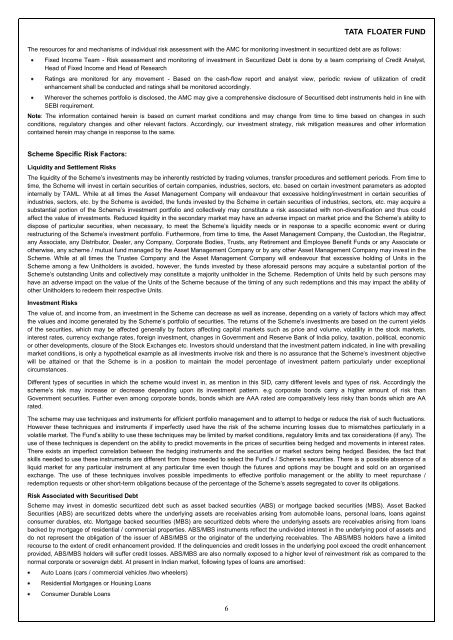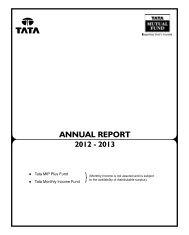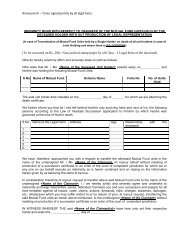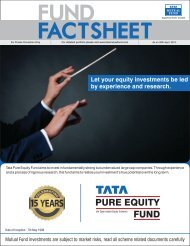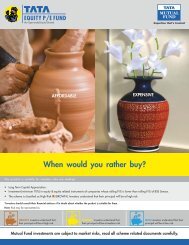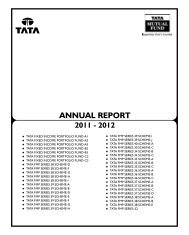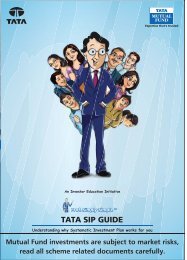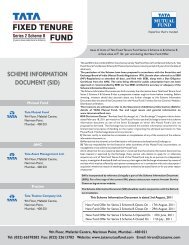Front Cover Page - Tata Mutual Fund
Front Cover Page - Tata Mutual Fund
Front Cover Page - Tata Mutual Fund
Create successful ePaper yourself
Turn your PDF publications into a flip-book with our unique Google optimized e-Paper software.
TATA FLOATER FUND<br />
The resources for and mechanisms of individual risk assessment with the AMC for monitoring investment in securitized debt are as follows:<br />
Fixed Income Team - Risk assessment and monitoring of investment in Securitized Debt is done by a team comprising of Credit Analyst,<br />
Head of Fixed Income and Head of Research<br />
Ratings are monitored for any movement - Based on the cash-flow report and analyst view, periodic review of utilization of credit<br />
enhancement shall be conducted and ratings shall be monitored accordingly.<br />
Wherever the schemes portfolio is disclosed, the AMC may give a comprehensive disclosure of Securitised debt instruments held in line with<br />
SEBI requirement.<br />
Note: The information contained herein is based on current market conditions and may change from time to time based on changes in such<br />
conditions, regulatory changes and other relevant factors. Accordingly, our investment strategy, risk mitigation measures and other information<br />
contained herein may change in response to the same.<br />
Scheme Specific Risk Factors:<br />
Liquidity and Settlement Risks<br />
The liquidity of the Scheme’s investments may be inherently restricted by trading volumes, transfer procedures and settlement periods. From time to<br />
time, the Scheme will invest in certain securities of certain companies, industries, sectors, etc. based on certain investment parameters as adopted<br />
internally by TAML. While at all times the Asset Management Company will endeavour that excessive holding/investment in certain securities of<br />
industries, sectors, etc. by the Scheme is avoided, the funds invested by the Scheme in certain securities of industries, sectors, etc. may acquire a<br />
substantial portion of the Scheme’s investment portfolio and collectively may constitute a risk associated with non-diversification and thus could<br />
affect the value of investments. Reduced liquidity in the secondary market may have an adverse impact on market price and the Scheme’s ability to<br />
dispose of particular securities, when necessary, to meet the Scheme’s liquidity needs or in response to a specific economic event or during<br />
restructuring of the Scheme’s investment portfolio. Furthermore, from time to time, the Asset Management Company, the Custodian, the Registrar,<br />
any Associate, any Distributor, Dealer, any Company, Corporate Bodies, Trusts, any Retirement and Employee Benefit <strong>Fund</strong>s or any Associate or<br />
otherwise, any scheme / mutual fund managed by the Asset Management Company or by any other Asset Management Company may invest in the<br />
Scheme. While at all times the Trustee Company and the Asset Management Company will endeavour that excessive holding of Units in the<br />
Scheme among a few Unitholders is avoided, however, the funds invested by these aforesaid persons may acquire a substantial portion of the<br />
Scheme’s outstanding Units and collectively may constitute a majority unitholder in the Scheme. Redemption of Units held by such persons may<br />
have an adverse impact on the value of the Units of the Scheme because of the timing of any such redemptions and this may impact the ability of<br />
other Unitholders to redeem their respective Units.<br />
Investment Risks<br />
The value of, and income from, an investment in the Scheme can decrease as well as increase, depending on a variety of factors which may affect<br />
the values and income generated by the Scheme’s portfolio of securities. The returns of the Scheme’s investments are based on the current yields<br />
of the securities, which may be affected generally by factors affecting capital markets such as price and volume, volatility in the stock markets,<br />
interest rates, currency exchange rates, foreign investment, changes in Government and Reserve Bank of India policy, taxation, political, economic<br />
or other developments, closure of the Stock Exchanges etc. Investors should understand that the investment pattern indicated, in line with prevailing<br />
market conditions, is only a hypothetical example as all investments involve risk and there is no assurance that the Scheme’s investment objective<br />
will be attained or that the Scheme is in a position to maintain the model percentage of investment pattern particularly under exceptional<br />
circumstances.<br />
Different types of securities in which the scheme would invest in, as mention in this SID, carry different levels and types of risk. Accordingly the<br />
scheme’s risk may increase or decrease depending upon its investment pattern. e.g corporate bonds carry a higher amount of risk than<br />
Government securities. Further even among corporate bonds, bonds which are AAA rated are comparatively less risky than bonds which are AA<br />
rated.<br />
The scheme may use techniques and instruments for efficient portfolio management and to attempt to hedge or reduce the risk of such fluctuations.<br />
However these techniques and instruments if imperfectly used have the risk of the scheme incurring losses due to mismatches particularly in a<br />
volatile market. The <strong>Fund</strong>’s ability to use these techniques may be limited by market conditions, regulatory limits and tax considerations (if any). The<br />
use of these techniques is dependent on the ability to predict movements in the prices of securities being hedged and movements in interest rates.<br />
There exists an imperfect correlation between the hedging instruments and the securities or market sectors being hedged. Besides, the fact that<br />
skills needed to use these instruments are different from those needed to select the <strong>Fund</strong>’s / Scheme’s securities. There is a possible absence of a<br />
liquid market for any particular instrument at any particular time even though the futures and options may be bought and sold on an organised<br />
exchange. The use of these techniques involves possible impediments to effective portfolio management or the ability to meet repurchase /<br />
redemption requests or other short-term obligations because of the percentage of the Scheme’s assets segregated to cover its obligations.<br />
Risk Associated with Securitised Debt<br />
Scheme may invest in domestic securitized debt such as asset backed securities (ABS) or mortgage backed securities (MBS). Asset Backed<br />
Securities (ABS) are securitized debts where the underlying assets are receivables arising from automobile loans, personal loans, loans against<br />
consumer durables, etc. Mortgage backed securities (MBS) are securitized debts where the underlying assets are receivables arising from loans<br />
backed by mortgage of residential / commercial properties. ABS/MBS instruments reflect the undivided interest in the underlying pool of assets and<br />
do not represent the obligation of the issuer of ABS/MBS or the originator of the underlying receivables. The ABS/MBS holders have a limited<br />
recourse to the extent of credit enhancement provided. If the delinquencies and credit losses in the underlying pool exceed the credit enhancement<br />
provided, ABS/MBS holders will suffer credit losses. ABS/MBS are also normally exposed to a higher level of reinvestment risk as compared to the<br />
normal corporate or sovereign debt. At present in Indian market, following types of loans are amortised:<br />
Auto Loans (cars / commercial vehicles /two wheelers)<br />
Residential Mortgages or Housing Loans<br />
Consumer Durable Loans<br />
6


